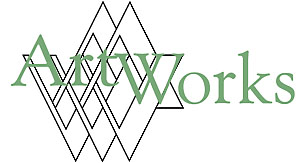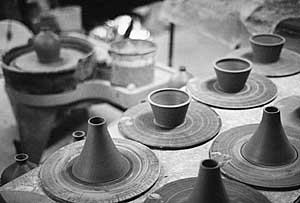
 |
Spring 2003 |
|
A textile artist takes his show on the road ADA: Arts for All ORBI to sponsor May ADA workshop From the Director Artist Fellowship winners announced MAAF update Strictly business Are children being left behind? Griffin wins national award Bringing writers together WV Writers annual conference |
Strictly business
|
 Pots and bases just off the wheel |
“When I first came down to Roane County, I had to find a means of self-support,” Omlor said. “You know, we have to support ourselves. I had gotten my Masters in art but it was more graphics, communication and photography. We didn’t have running water, lived in very primitive circumstances and had no money. I couldn’t continue in photography, but I wanted to continue in some kind of creative expression. |
 The Blessing Cup |
“I saw this little old root cellar behind the house with a run-down 12x12 room on top of it. I started dreaming and thought maybe pottery was the thing to do. But that takes time; you have to get a wheel and a kiln, and I didn’t have any money. Some folks came to me and said they wanted socialization for their children before they went to school. These folks were part of the back-to-the-land movement and living way back in the hills. They asked me if we could do some kind of preschool. I was very excited about that.” |
Omlor and the parents created a cooperative, the Pumpkin Patch. “It took off like wildfire. I stressed creative arts: painting, art, music and cooperative drama. We had three- and four-year-olds, and we always had a full house. Parents helped me. They were my assistants. That went for seven years and probably a bit before that closed I started doing pottery.”
Omlor’s setup at the time was in itself a challenge. “I had a used kiln with no place to put it but a rickety woodshed. There was no room. I had to carry all my pots down the steps of the root cellar and across the yard to the shed. It was difficult and inconvenient; I had no running water and had to bring in rainwater. It was tough, but I got started and I practiced a lot and I learned a lot.”
|
Dealing with tough stuff is a motif in Omlor’s life. When she entered the Order of Saint Francis and the Mother House in Tiffen in 1962, she realized the true meaning of the phrase farming community. “I was a town kid and there I was in a community of farmers. The first week I was cleaning chickens and making sausage, picking berries, digging potatoes. It was hard manual labor. We were pretty much a subsistence community and supported a home for the aged and a boarding school. A good preparation to simple country living, indeed.” |
 Sister Jane Omlor trims a pot |
Omlor recounts what seems like a lifetime before pottery: A postulant, a novice, college, instructor in small rural grade schools for seven years, Masters Degree at Notre Dame University and eight years teaching in an alternative high school. “I then went to a house of prayer in Butler, PA, for one year.” She takes a breath and smiles, “It was a very excellent experience, a contemplative experience. And from Butler I found my way down to Colt Run.”
In Omlor’s studio, there is a picture of her standing gleefully and ankle deep in what looks like almond butter crème frosting. “When I saw all the mud down in Colt Run, clay came to mind.” For her, the move to pottery “just seemed like a natural outgrowth of living close to the earth. In pottery you are working with the earth, with the clay. So it sort of flowed from my life and what I was about — and it worked.”
Omlor took a couple of workshops, but, for the most part, she is a self-taught potter. “By the time I got to Big Laurel in Mingo County in 1997 I was pretty much established, going to some shows in Connecticut. I had to decide what kind of pottery I was going to do. We have a lot of excellent potters in West Virginia, so I couldn’t do the same old, same old and try to compete with these people. I came up with idea of family community ritual pieces, pieces that were mainly used for rituals in the home. People can gather around the pottery and it would, as I say, ‘enhance the spiritual dimension of everyday life.’ So, these are all original pieces, very simple, and I have a tag that goes with them that has a suggested ritual.”
|
Her idea found an enthusiastic audience. “People are hungry for something to celebrate on a spiritual level in their homes. It helps to have something to hold and to gather around.” Omlor’s line of pottery includes the Blessing Cup, Angel Lantern, Nativity Lantern, Blessing Lamp, Night Light and One Light Prayer Lantern. “It’s a very contemplative kind of work, and when you finally have it down it becomes effortless. You sit and you throw. It’s quieting and you have to be centered to do it. And living eight miles off a hard-top road, it’s nice to be able to work right up here on the mountain.” The Nativity Lantern was so successful that with the proceeds, and a great deal of volunteer help, Omlor was able to build the Chapel of the Nativity, a straw-built chapel on Colt Run. |
 Michelle Bryant and Sister Jane Omlor |
Even though she is successful with her work, Omlor doesn’t see her life in that context only. “I probably could be a super-duper potter if that’s all I did. But I think women tend to [focus on] relationship rather than just being focused things. I love working with children. I think that’s one reason why I was motivated to do the ecology center, to ensure that there would always be a presence of children up here.”
“Up here” would be Big Laurel, a stunner of a mountain sitting resolutely amidst the clamor of what sounds like the pylon drivers of a new pier. For the past 25 years the mountain has been home to an educational community inspired by local legend and visionary, Edwina Pepper. Pepper loved the people and the land of this area. She created the Big Laurel School, now the Big Laurel Learning Center, which is still active under the leadership of its two original teachers. Omlor’s studio is in Edwina Pepper’s former home, a mile down from the Learning Center and a stone’s throw from the Ecology Center.
Michelle Bryant, Omlor’s neighbor, sometime helper and former student of the School for Learning, was born on Big Laurel and typifies the spirit and intelligence of the people that Edwina Pepper loved. Bryant admires Omlor’s hard work and artistry, and said, “Edwina would love that Jane is here. She would love that there is an artist here.”
Not just an artist, but a teacher, guide and dreamer. Sister Jane Omlor is a very busy person.
Contact Sister Jane F. Omlor and Colt Run Pottery at P.O. Box 27, Naugatuck, WV 25658. The e-mail address is: [email protected]. Contact Bonnie Fuoco at P.O. Box 162, Lewisburg, WV 24901 or by e-mail: [email protected].